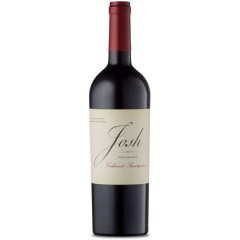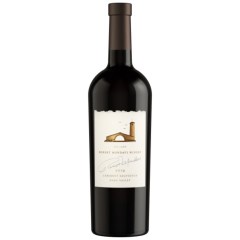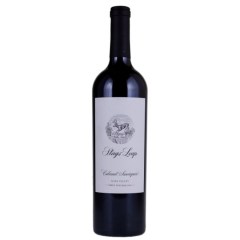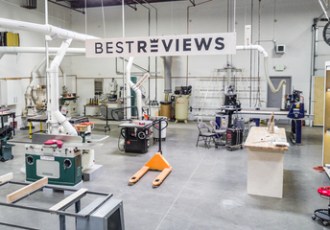BestReviews is reader-supported and may earn an affiliate commission. Details

An opulent and highly esteemed wine representative of the Napa style of cabernet.
An opulent and highly esteemed wine representative of the Napa style of cabernet.
Rated 91-97 points by the major wine critics for the past several vintages. Soft tannins provide structure to lush dark fruit flavors and aromas of florals and earth. Drinkable taste now but is also worth cellaring as an investment.
Somewhat expensive. May need a couple of years to show best flavors.

An accessible, flavorful, versatile cabernet under $20 that goes with just about anything.
An accessible, flavorful, versatile cabernet under $20 that goes with just about anything.
Crowd-pleasing; great for dinner parties or for sipping on its own. Full-bodied taste with a long finish full of flavor, especially dark fruit and cinnamon. Versatile food pairing. About 5 g/L of sugar; 13.5% alcohol by volume. Easy to find.
May be too dry for some. Not the most complicated of cabernets.

An approachable yet consistently rewarding Napa Valley cabernet with a noticeably dark color.
An approachable yet consistently rewarding Napa Valley cabernet with a noticeably dark color.
Rated 90-93 points over the past several vintages. Distinctive dark color with aromatic woody notes like sandalwood and oak. Dark fruit and ripe tannins reward immediate drinking. Tastes great with lean roast beef.
Drinking too early may waste more flavor development with age.

A solid and consistent cabernet from a famous and respected name in California wine.
A solid and consistent cabernet from a famous and respected name in California wine.
Wins 91-92 points from wine critics for the most recent vintage. Medium-full body taste is pleasant to drink, with fresh aromas of herbs and spices. Creamy tannins and pleasing finish. Juicy. Good with lamb chops.
Big alcohol at 15.5% by volume.

Slightly cooler elevations bring a fruitier taste to this cabernet from a famed and historic label.
Slightly cooler elevations bring a fruitier taste to this cabernet from a famed and historic label.
Full body with fine, crisp tannins. Juicy cherry and blackberry flavors are joined by rose and tobacco notes. Refreshing with balanced acidity. Approachable and drinkable now, but can withstand aging. Pairs with many foods.
No significant cons at this price.

We recommend these products based on an intensive research process that's designed to cut through the noise and find the top products in this space. Guided by experts, we spend hours looking into the factors that matter, to bring you these selections.

Ideal for winding down the day, pairing with a meal, or enjoying with friends, wine is one of the most popular and oldest drinks in the world, appealing to both connoisseurs and casual sippers, old and (not too) young alike. Among the most diverse and embraced types is cabernet sauvignon, a red wine grape variety that is a relatively new wine (emphasis on “relatively”) and easy to make.
Cabernet sauvignon (pronounced “kab-er-nay saw-vin-yawn”) wines are full-bodied reds with high tannin levels and moderate acidity. Cabernet was created in the 1600s in France as a blend of sauvignon blanc and cabernet franc, but today it’s made around the world, and as such, is the most popular wine variety in the world. Cabernet is often paired with meals, particularly smoked meats, beef, lamb, and hard cheeses.
As there are many varieties and blends of wine, and many different vineyards of each type, it’s important to know what you like or may like, and how to discern what wine is best for you and your lifestyle. Our buying guide and recommendations can help break down the important details so you can go forth on your wine journey with the proper knowledge.

While cabernet sauvignons can come in many different forms, they all generally share some commonalities. These are the five general characteristics of wine and how cabernet sauvignon fits into the categories.
Bitter: Tannins produce a dry, bitter taste. You’ll find them in several different foods, including dark chocolate, certain nuts, whole spices, and tea leaves. They’re also found in wood and grapes, which is how they end up in wines. Tannins are primarily found in red wine, particularly cabernet. Tannins tend to dry out your mouth, but high tannin levels can add longevity, complexity, and balance to wine.
Sweet: Cabs tend to be dry, but some, especially the less expensive ones, may have a hint of sweetness. This will likely be the first thing you notice when tasting wine.
Acid: Tartness in wine is caused by acidity. Most cabs have medium acidity, less than white wine but more than coffee.
Alcohol: An average glass of wine contains between 11% and 13% alcohol. Cabs are a little higher, with an average of 13.5% to 15% alcohol by volume (ABV). One way to notice higher alcohol content is by how much the wine warms the back of your throat.
Body: Cabernet sauvignon is a full-bodied red wine, a term that refers to a combination of the complexity, texture, and taste of the wine. Lighter wines are usually easier to drink and go down more quickly, while full-bodied wines tend to be enjoyed more deliberately. The body of a wine is made up of a combination of the aforementioned traits.
Cabernet sauvignon has a predominant taste of black fruits, from currants to plums, berries to cherries. This quality makes the taste of the wine fuller and bolder. Cabs may also be oaky or woody, with some cabs predominantly fruity and others smokier.
Due to the versatility of the grape, cabernet sauvignon can be made around the world. While all areas share common traits, each region adds subtle notes of flavor. For example, cabs from Northern California may have a slight mint or tobacco taste, while those from South America may feature green peppercorns. If you’re new to cabs and want to go to the source, be sure to try a bottle from the Bordeaux region of France.
It’s worth knowing the ideal way to serve cabernet sauvignon. It’s best enjoyed at or just below room temperature (between 60°F and 68°F) in an oversize wine glass. Older bottles should be decanted for an up to an hour, but failing that, let the wine sit and breathe in your glass before enjoying.




















When searching for cabernets, you may find some bottles sealed with a cork and others with a screw cap. While some older wine connoisseurs may be adamant that cork is superior, there is little to suggest that one top makes wine taste better or worse than the other. Corks may in fact disintegrate and taint the wine, especially older corks. Screw caps tend to lower the cost of the wine and are easier to open and close. Ultimately, the option may come down to personal preference, though most Australian wines use screw caps.
Green bell pepper: Once regarded as a fault of under-ripened grapes in the winemaking process, today there are many who seek out such odd flavors found in cabernets. A green bell pepper taste is caused by aromatic organic compounds called pyrazines. You’re likely to find the green bell pepper flavor in cabernets made in cooler regions where the grape may not ripen as quickly or even fully.
Mint and eucalyptus: These are two more somewhat exotic flavors when it comes to cabernets. Mint can be found in wines from medium climates, those warm enough to avoid high pyrazine levels but that still trend cooler, such as Australia. Eucalyptus is another distinct and sought after flavor that tends to be found in Australian and Californian cabs made in regions where you find eucalyptus trees.

Decanter: Wine Enthusiast Decanter
After opening your bottle of cabernet, it’s useful to decant it to allow it to aerate properly and reach its maximum potential. We love this beautiful crystal decanter from Wine Enthusiast.
Wine opener: HiCoup Kitchenware Corkscrew
If your wine bottle has a cork, you need the proper tool to open it. We like this simple yet effective corkscrew from HiCoup Kitchenware. The handle comes in 27 different inlays of wood or resin.
Wine preserver: OXO Vacuum Wine Saver
If you have a quality bottle of wine that you don’t finish, you need a way to preserve the flavor until you can enjoy it again. This steel OXO vacuum preserver will keep your bottle of cabernet fresh until next time.
Wine rack: MyGift Folding Wine Rack
Buying wine in bulk is a good way to save money and be prepared for your next gathering, but you’ll need a place to store all those bottles safely. We love this folding wine rack that holds up to 54 bottles and requires no tools to assemble.

Prices of wine in general and cabernet sauvignon, in particular, vary widely based on the year and region in which it was made, the winemaker, and the demand for the specific type.
Inexpensive: For under $40, you can find a quality bottle of cabernet from various regions around the world, usually made within the last three years.
Mid-range: For between $40 and $100, you can find high-quality bottles from around the globe, including those from well-regarded makers and vineyards. These wines may be highly rated and made within the last five years.
Expensive: For over $100 and up to $1,000 and more, you can find the finest cabernets. Prices rise dramatically depending on the vintage and the rarity of the wine.

There are virtually infinite options when it comes to buying cabernets, so naturally, there are many, many more that caught our eye. For a quality Italian cab featuring dusty tannins, black cherry notes, and lingering spice, check out the Collazzi Toscana IGT from 2016.
If you’re in the mood for a high-end, rich, and complex Napa Valley cab, consider this 2016 offering from Carte Blanche.
Last, in the medium price range comes a 2013 cab from Hidden Ridge in Sonoma County, California, featuring strong hints of ruby and notes of blackcurrants, vanilla, and oak.

Q. Why don’t I taste all the notes?
A. It’s perfectly normal for wine drinkers not to access or notice all the notes and aromas listed for a bottle of wine. Some people have more sensitive palates, while others are simply better at detecting scents and tastes. Remember, when it comes to wine for the average consumer, it’s about what you enjoy. You don’t need to explain the wine to love it.
Q. What are the best meals to pair with cabernet sauvignon?
A. Because cabs are generally potent and bold, it’s best to avoid mild dishes that can be overwhelmed by the wine. Lamb, beef, and other meaty dishes are ideal. Pasta also goes well with cabs. It’s wise to stay away from spicy dishes. Still, cabs from different regions and even different vineyards have optimal pairings that differ from the norm, so it’s best to look into each specific wine.
Q. How long will cabernet sauvignon last once the bottle is opened?
A. Most red wine will only last a few days once opened. A wine preserver may improve the longevity up to a week, but it’s best to enjoy the wine within a day or two to get the most out of it. Consider how much you and your guests will be able to drink before opening a bottle, especially a more expensive one.
Get emails you’ll love.
Learn about the products you’re wondering if you should buy and get advice on using your latest purchases.
